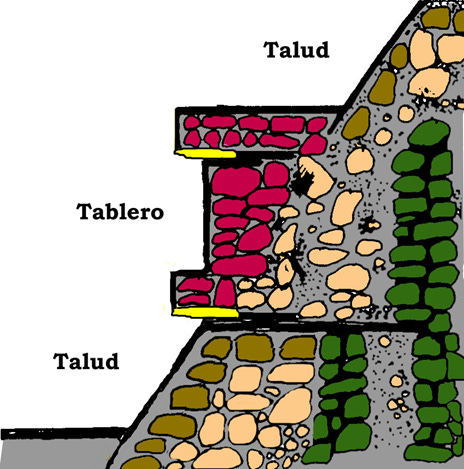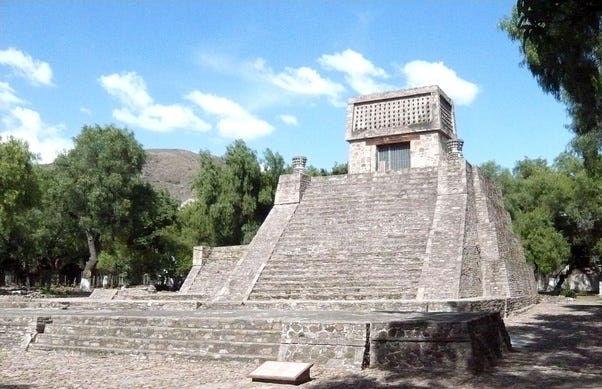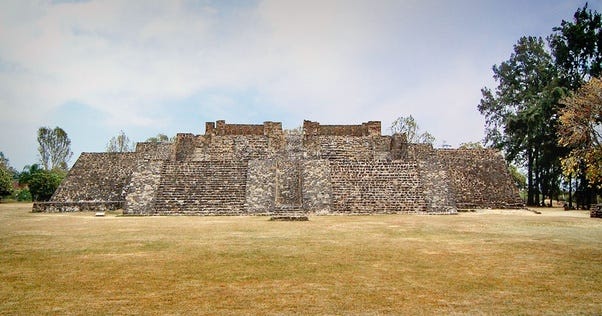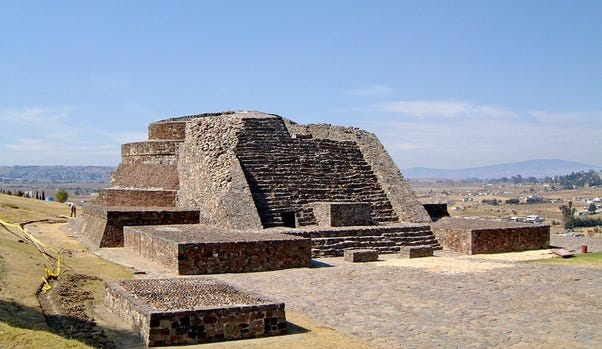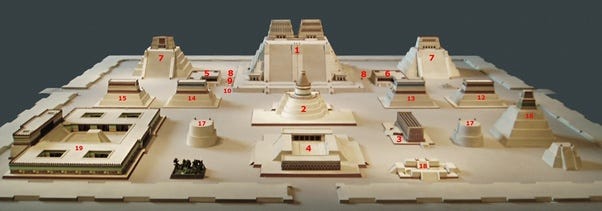Temple Architecture Styles : Aztec Architecture
Aztecs were a multi-ethnic Mesoamerican culture that flourished in present-day central Mexico (United Mexican States) in the post-classic period during 1300 CE – 1521 CE. Aztec Architecture flourished under Aztecs in central Mexico during this period — most religious structures built by Aztecs were built over existing temples inherited from their conquests of those areas, and continued to be rebuilt later on, therefore showing several layers of building.
Definition of Aztec and Usage of the term in this post:
The definitions of Aztec and Aztecs have long been the topic of scholarly discussion ever since German scientist Friedrich Wilhelm Heinrich Alexander von Humboldt established its common usage in early 19th century CE. The Nahuatl words aztēcatl (Nahuatl pronunciation: [asˈteːkat͡ɬ], singular) and aztēcah (Nahuatl pronunciation: [asˈteːkaʔ], plural) mean "people from Aztlan", a mythical place of origin for several ethnic groups in central Mexico. The term was not used as an endonym by Aztecs themselves, but it is found in the different migration accounts of the Mexica, where it describes the different tribes who left Aztlan together. In one account of the journey from Aztlan, Huitzilopochtli, the tutelary deity of the Mexica tribe, tells his followers on the journey that "now, no longer is your name Azteca, you are now Mexitin [Mexica]". In today's usage, the term "Aztec" often refers exclusively to Mexica people of Tenochtitlan (now the location of Mexico City), situated on an island in Lake Texcoco, who referred to themselves as Mēxihcah (Nahuatl pronunciation: [meːˈʃiʔkaʔ], a tribal designation that included the Tlatelolco), Tenochcah (Nahuatl pronunciation: [teˈnot͡ʃkaʔ], referring only to the Mexica of Tenochtitlan, excluding Tlatelolco) or Cōlhuah (Nahuatl pronunciation: [ˈkoːlwaʔ], referring to their royal genealogy tying them to Culhuacan). Sometimes the term also includes the inhabitants of Tenochtitlan's two principal allied city-states, Acolhuas of Texcoco and Tepanecs of Tlacopan, who together with the Mexica formed Ēxcān Tlahtōlōyān (Aztec Triple Alliance) that controlled what is often known as "Aztec Empire".
To the Aztecs themselves the word "aztec" was not an endonym for any particular ethnic group. Rather, it was an umbrella term used to refer to several ethnic groups, not all of them Nahuatl-speaking, that claimed heritage from the mythic place of origin, Aztlan.
This post will use the meaning of Aztec as close to the endemic meaning as possible.
General Architecture Features:
Teocalli (Pyramid-Temples): Aztecs primarily constructed Teocalli, pyramids surmounted by temples, as the major religious structures in their cities → this term is synonymously used with temple in case of Aztecs.
Teocalli were constructed in accordance to the 4 cardinal directions. They were normally erected on the eastern border of the town centre or plaza, facing west. If a new teocalli was to replace an already existing teocalli, the builders would add a new structure over the existing edifice resulting in a new teocalli that was larger, more extravagant, and more detailed.
The appearance of most teocalli was similar, resembling truncated pyramids. The outside of the teocalli had terraces and steps. Some of the common features of Aztec teocalli are: 13 steps along the stairway, staircases with 2 balustrades with changing slopes at the top almost becoming vertical, and representations of an eagle that is the nahual (disguise or form) of Huītzilōpōchtli-Tonatiuh.
The tops of the pyramids had small flat plateaus where a temple or a sacrificial block of a temple was built. An adjoining back room contained the idol to whom the temple was dedicated and an antechamber for a priest.
Most temples’ inside walls were ornamented with either sculpture or paint. Temples were also decorated with geometrically carved blocks of stone. Some of the most detailed and decorated parts of the teocalli were the staircases that pointed towards the heavens. Stone serpent heads were frequently placed at the end of the staircases — serpent heads’ signified the representation of Coatepec (Snake Mountain), as the place of birth of the Aztecs’ main deity Huītzilōpōchtli. It was also believed that evil spirits would be warded away by using poisonous or dangerous animals for décor.Building Techniques
Talud-tablero: Talud-tablero consists of an inward-sloping surface or panel called the talud, with a panel or structure perpendicular to the ground sitting upon the slope called the tablero. Talud-tablero was often employed in pyramid construction, found in Pre-Columbian Mesoamerica. It is found in many cities and cultures but is strongly associated with the Teotihuacan culture of central Mexico, where it is a dominant architectural style.
Index:
Development
1200 CE – 1521 CE
Tetzcoco āltepētl (1200 CE – 1428 CE)
Mexico-Tenochtitlan āltepētl (1325 CE – 1428 CE)
Mēxihco-Tlatelōlco āltepētl (1337 CE – 1473 CE)
Tlacōpan āltepētl (founded 1428 CE, then joined Ēxcān Tlahtōlōyān)
Ēxcān Tlahtōlōyān triple alliance (1428 CE – 1521 CE)
Polities:
Āltepēme (singular : Āltepētl) were ethnic polities of pre-Columbian Nahuatl-speaking societies in Americas. Local rulers of āltepēme generally retained their authority over taxation and land distribution while under the indirect rule of an empire in exchange for their submission, participation in military campaigns, and tribute payments.
Mēxihcah people settled on an island in Lake Texcoco and founded the āltepētl of Mexico-Tenochtitlan on the southern portion of the island in 1325 CE. In 1337 CE, a group of dissident Mexica broke away from the Tenochca leadership in Tenochtitlan and founded Mēxihco-Tlatelōlco on the northern portion of the island. Tenochtitlan was closely tied with its sister city, which was largely dependent on the market of Tlatelolco, the most important site of commerce in the area.
Ēxcān Tlahtōlōyān triple alliance was formed by alliance of of 3 Nahua Āltepēme: Mexico-Tenochtitlan, Tetzcoco, and Tlacōpan. The empire later conquered many other āltepēme including Xochimilco (900 CE – 1430 CE), Azcapotzalco (995 CE – 1428 CE), Cōlhuàcān, Tenanyohcān, Mēxihco-Tlatelōlco and Coixtlahuaca.
Ēxcān Tlahtōlōyān and remaining āltepēme were conquered by Spanish colonialists in 16th century CE. Aztec architecture’s development ceased, and many Aztec structures were either destroyed or converted to Christian usage.
→ Ēxcān Tlahtōlōyān in 1519 CE [Source: File:Aztec Empire 1519 map-fr.svg - Wikimedia Commons]
Temples:
Aztecs usually constructed their teocalli over existing structures inherited from their conquests of the āltepēme of present-day Valley of Mexico. These structures often continued to be rebuilt later on, therefore showing several layers of building.
Tenanyohcān (walled city; now Tenayuca) archaeological site in Valley of Mexico has the oldest Aztec double pyramid (twin-staircase rectangular teocalli) constructed by joining two pyramidal bases to support two separate temples.
→ Tenanyohcān teocalli in Tenanyohcān (Tenayuca), Tlalnepantla de Baz, State of Mexico, United Mexican States — it is the earliest example yet found of the typical Aztec double pyramid (twin-staircase rectangular teocalli). It consists of joined pyramidal bases supporting two temples: Tláloc temple in north and Huītzilōpōchtli in south. [Source: File:Tenayuca.jpg - Wikimedia Commons]
Structural Details
Aztec architecture is characterized by symmetry and elements like geometric designs and sweeping lines. Other key stylistic traits include the use of "bas-reliefs, walls, plazas, and platforms as media to represent their deities and ideals," according to Manuel Aguilar-Moreno. The style of early Aztec teocalli was influenced by those of Classic and other Postclassic Mesoamerican societies. Aztec architecture subsequently influenced later Mesoamerican styles.
Building material and techniques
Building material
Aztec Teocalli were usually constructed with stone allowing them to survive longer compared to other structures.
Building strong foundations was necessary since the soil was swampy and it could damage the foundations. Volcanic stone called tezontle was used in the construction of the base while materials such as rubble and limestone were also used in construction.
Talud-tablero building technique
Talud-tablero consists of an inward-sloping surface or panel called the talud, with a panel or structure perpendicular to the ground sitting upon the slope called the tablero.
Talud-tablero was often employed in pyramid construction, found in Pre-Columbian Mesoamerica. It is found in many cities and cultures but is strongly associated with Teōtīhuacān culture of central Mexico, where it is a dominant architectural style.
→ Talud-tablero:
Schematic representation of the talud-tablero style used in many Mesoamerican pyramids [Source: File:TableroTalud.jpg - Wikimedia Commons]
An overview of differing Talud-tablero styles used by different Mesoamerican cultures [Source: File:Taludtablerostyles.png - Wikimedia Commons]
Decorative elements
Aztec religious decorative elements were usually reliefs and sculptures.
Most temples’ inside walls were ornamented with either sculpture or paint. Temples were also decorated with geometrically carved blocks of stone. Some of the most detailed and decorated parts of the teocalli were the staircases that pointed towards the heavens. Stone serpent heads were frequently placed at the end of the staircases — serpent heads’ signified the representation of Coatepec (Snake Mountain), as the place of birth of the Aztecs’ main deity Huītzilōpōchtli. It was also believed that evil spirits would be warded away by using poisonous or dangerous animals for décor.
→ Sculpted glyphs on the stone bench inside the temple shrine of El Tepozteco in Tepoztlan, Morelos, United Mexican States [Source: File:El Tepozteco 2.jpg - Wikimedia Commons]
→ Serpent decoration of Tenayuca teocalli [Source: Tenayuca - Wikipedia]:
Coatepantli (Serpent wall) surrounds the entire base of the pyramid. Below images are of northwest (left) and southwest (right) portions
Coiled serpent sculpture at north (left) and south (right)
Aztec Teocalli and Teocalli Complexes
Aztec Teocalli
Teocalli were constructed in accordance to the 4 cardinal directions. They were normally erected on the eastern border of the town centre or plaza, facing west. If a new temple was to replace an already existing temple, the older temple was not destroyed. Rather, builders would add a new structure over the existing edifice resulting in a new temple that was larger, more extravagant, and more detailed. Enlarging pre-existing structures meant adding more stairs and making the sacrificial area more spacious. According to the emperor, layering a pre-existing temple was acceptable as the deities had already blessed the original temple. Building a more magnificent temple paid further tribute to the deities. The appearance of most teocalli was similar, resembling truncated pyramids. The outside of the temples had terraces and steps.
Most Aztec pyramid-temples followed a general pattern that consisted of a platform, a long broad, steep double staircase rising from the centre, with balustrades along the sides of the steps. Sculpted stone blocks and skulls were used to decorate the platform and the end of the balustrades. The tops of the pyramids had small flat plateaus where a temple or a sacrificial block of a temple would be built. An adjoining back room contained the idol to whom the temple was dedicated and an antechamber for a priest. Most temples’ inside walls were ornamented with either sculpture or paint. Temples where also decorated with geometrically carved blocks of stone.
Some of the most detailed and decorated parts of the temple were the staircases that pointed towards the heavens. Stone serpent heads were frequently placed at the end of the staircases — serpent heads’ signified the representation of Coatepec (Snake Mountain), as the place of birth of the Aztecs’ main deity Huītzilōpōchtli. It was also believed that evil spirits would be warded away by using poisonous or dangerous animals for décor.
Early Aztecs built pyramids in a style similar to the ones of earlier Classic and Post-Classic Mesoamerican people. However, there were some differences — some of the common features of Aztec teocalli include: 13 steps along the stairway, staircases with two balustrades with changing slopes at the top almost becoming vertical, and representations of an eagle that is the nahual (disguise or form) of Huītzilōpōchtli-Tonatiuh. The elements can be seen on temples at Tepoztlan, Temple of the Feathered Serpent in Xochicalco, the round temple of Cempoala, and the temple of Ehēcatl in Calixtlahuaca.
Types of Aztec Teocalli
Common types of Aztec Teocalli include the following:
Single-stairs rectangular Teocalli
Twin-stairs rectangular Teocalli
Round Teocalli
Single-stairs rectangular Teocalli feature single staircase and single temples at their summits. These were the simplest of the 3 main types of pyramids.
Twin-stairs Teocalli feature two staircases and two temples at their summits. The staircases were usually long broad, with balustrades along the sides of the steps. Sculpted stone blocks and skulls were used to decorate the end of the balustrades. Notable examples include Huēyi Teōcalli (Great Temple of Tenochtitlán).
Round Teocalli are predominantly found in Calixtlahuaca, in the Toluca Valley. They are dedicated to the deity of the wind Ehēcatl, one of the forms of Quetzalcōātl. The structures were constructed in a circular fashion to facilitate wind flow thereby preventing the structure from acting as a barrier that could hinder the wind deity’s entrance. According to Aztec and other pre-Columbian beliefs, Ehēcatl blew wind in the four cardinal directions so that the earth would be cleansed, enabling Tláloc to send rain: gentle wind would be sent to the east in the direction of Tlālōcān (paradise of deity Tláloc), Gales would be sent to north in the direction of Mictlān (the underworld), gentle cold wind blew to the west where the Cihuapipiltin/Cihuateteo (divine women; noble women who died while giving birth) stayed, and strong gusty winds blew to the south where Centzonhuītznāhua (stars of the south) resided.
→ Aztec teocalli:
Single-staircase rectangular teocalli : Pyramid of Santa Cecilia Acatitlan, Tlalnepantla de Baz, State of Mexico, United Mexican States [Source: File:StaCeciliaAcatitlanNorte.jpg - Wikimedia Commons]
Twin-stairs rectangular Teocalli : Building 1 of Teopanzolco, Cuernavaca, Morelos, United Mexican States [Source: W0057 Teopanzolco: Great Platform (Building 1) | Uncovered History]
Temple of Quetzalcōātl in Calixtlahuaca (founded by Aztecs over the conquered city Matlatzinca) in [Source: W0030 - Calixtlahuaca: Temple of Quetzalcoatl East | Uncovered History]
Aztec Shrines
Aztec shrines were important religious structures. Since the Aztecs were polytheistic, each shrine that was built was to honour a specific deity. Since different shrines worshiped a specific deity, their respective appearances were relatively diverse. Although shrines’ exteriors varied, their internal structure was more uniform. The interior usually had a circular form with a round table in the middle of the room that was used to hold the offerings to the cult of the deity to whom the shrine was built. Since the Aztecs were extremely devout and had many offerings, there usually was not enough room for all the offerings on the shrine. It was not uncommon for an additional building to be added. The adjoining structure consisted of a rectangular building leading to a smaller round room where there was a fire in the centre to burn offerings — often the second building would burn down because the roof was thatched of grass and straw. These shrines played an integral part in the religious lives of Aztecs who strongly believed that offerings were essential in pleasing the deities. Examples of these shrines are found in Mount Tlaloc and in Huixachtepetl or Hill of the Star (presently Cerro de la Estrella).
Aztec Temple Complexes (Teocalli Complexes)
Aztec temple complexes usually had a main teocalli surrounded by subsidiary structures including smaller teocalli, shrines and other associated structures.
→ Huēyi Teōcalli complex in Tenochtitlan, present-day Mexico City, United Mexican States [Source:File:Templo Mayor model with numbers.jpg - Wikimedia Commons]
1. Twin-stair Huēyi Teōcalli dedicated to Huītzilōpōchtli & Tláloc 2. Semi-circular Teocalli dedicated to Ehēcatl-Quetzalcōātl 3. Tzompantli 4. Ballcourt 5. House of Eagles 6. House of Jaguars 7. Tezcatlipoca Temple 8. Southern Red Temple and Northern Red Temple 9. Tzompantli Altar 10. Shrine A 12. Temple of Xōchiquetzal 13. Temple of Chicomecoatl 14. Temple of Cihuacōātl 15. Temple of Coacalco 16. Temple of Tonatiuh (Temple of the Sun) 17. Shrine of Ehēcatl 18. Tozpalatl
External Links











